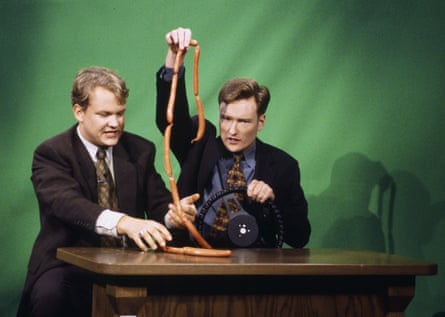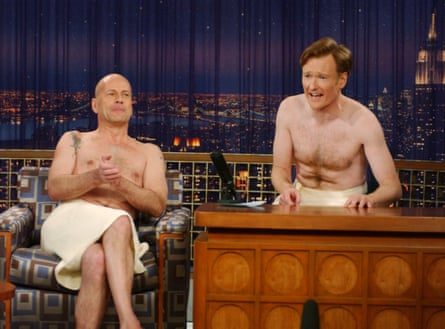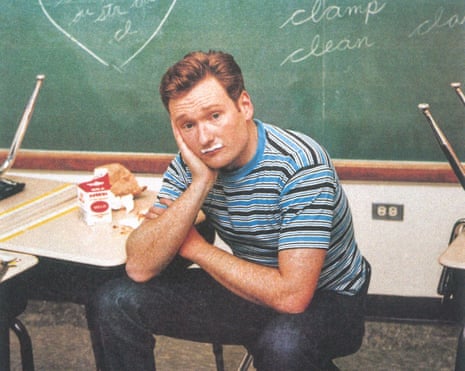Like Buster Keaton, Gene Kelly, and Jackie Chan before him, Conan O’Brien shows his genius in his adaptivity, the ability to insert himself into any setting and incorporate its material into the contours of his act. He gave a tour-de-force demonstration during his recent, instantly viral, appearance on Hot Ones, where he treated the show’s premise – guests eat chicken wings while answering questions – as a jumping-off point for his own anarchic brand of comedy. He brought along his longtime staff writer José Arroyo in character as “Dr Arroyo”, an incompetent yet affordable physician on hand to ensure that O’Brien’s gentle Irish constitution could withstand all the spice. After finishing each hot wing, O’Brien stashed the bones in his pocket until it bulged to capacity, at which point he started stuffing them in Dr Arroyo’s lab coat. He maintained his composure admirably through the escalating Scoville spiciness scores, only to hit a sudden wall on the penultimate wing and swiftly lose his mind. Expelling rivers of phlegm and drooling mouthfuls of milk, he then delivered a manic yet moving grand-finale soliloquy on the beauty of humor coming from anywhere.
Like so many of O’Brien’s finest moments, it was unabashedly weird, hysterically funny, and sneakily poignant.
O’Brien had dropped by Hot Ones to promote Conan O’Brien Must Go, a travel series new to Max (“That really rolls off the tongue,” he mocked the streaming service formerly known as HBO) that he hopes will leave viewers with less knowledge about the parts abroad he visits. He considers himself less of a cultural ambassador than a roving clown, forever searching for fresh settings he can bounce himself off of. In the pilot, that’s Norway, where he visits a salmon farm and learns about Vikings, but mostly is there to make the acquaintance of Jarle, a Crocs-clad rapper O’Brien spends most of the encounter faux-berating for his shabby clothes, disorderly apartment and questionable hygiene. No matter where he goes, O’Brien plants the flag of Team Coco.

In the days following the Hot Ones internet-breakage, a deluge of fans’ social media posts fondly recounted O’Brien’s greatest hits and mapped his omnivorous curiosity: over three decades on camera, he’s submitted to a dominatrix in Germany, enlisted with civil war re-enactors in Georgia, learned survival skills in the Australian outback, and joined a Long Island living history museum’s old-timey baseball team. The outpouring of appreciation underscored the exceptional enduring appeal of this self-determined cult figure who’s gone where no one else on late night dared venture – not just geographically, but in terms of taste. And in 2024, he’s more relevant than ever, as an anomaly amid today’s flattened late-night landscape of broad agreeability.
The details of O’Brien’s professional trajectory have ossified into comedy legend, in part for how they imply a defiant commitment to pursuing his muses down their strangest avenues, then finding success anyway. A big-break position on the writing staff of Saturday Night Live in 1988 led him to a spot in the writers’ room for The Simpsons during an unimpeachable early run that still places the show near the forefront of the Greatest Sitcom of All Time conversation. His sensibility – best exemplified in the episode Marge vs the Monorail, which paid homage to The Music Man and the disaster epics of Irwin Allen between jokes about Leonard Nimoy and a mutant squirrel with laser eyes – favored a winning combination of density, obscurity and aggressive absurdity.
When David Letterman acrimoniously parted ways with NBC and O’Brien landed the vacant Late Night gig in 1993 despite “about 40 seconds” of on-camera experience, he gained just the right platform for his singular brand of shtick: at half-past midnight, he reached a national audience of insomniacs willing to follow him wherever he led.

The foundation of all comedy is the reversal of expectations, and O’Brien treated the concept of the talkshow like a set-up he could subvert with his own punchlines. Reared on the imaginative form-pushing of The Tonight Show under Johnny Carson, O’Brien understood the tropes of the genre and how he could turn them in on themselves: a given episode might see the audience replaced with giggling children, or puppeteered skeletons taking the place of everyone onscreen with their audio dubbed in. Paul Rudd’s guest appearances made a gleefully dumb bit out of the standard promotional clip played to showcase a celebrity’s latest project, with Rudd’s every set-up invariably leading back to the same snippet of the film Mac and Me. A riff on the time-honored fun-with-animals segment was a diamond of comic construction: a dog trainer explained that a padded suit would make a volunteer perfectly safe from his canine charge’s jaws, only for the pooch to pull out a gun and shoot him dead.
O’Brien’s early seasons were infamously rocky, his low ratings keeping him on the razor’s edge of cancellation by the NBC suits who constantly played the antagonists in his mad little universe. Complaints from prudish NBC affiliates requesting that he work a little less blue led to the birth of the Masturbating Bear, a diaper-clad grizzly known for “batting at his genitalia frantically”. O’Brien’s flagrant disregard for mass commercial appeal put him at permanent odds with management, a distinctly Gen X conflict between fighting the Man and selling out that spoke to a deeper sense of integrity. He proved it during the 2007-2008 writers’ strike, when he boldly went to air without a script and created deliberately tedious television (he killed time by making America watch him spin his wedding ring on his desk for a record-breaking 51 seconds) to make a point about how badly he needed his people.

The ultimate indignity came when NBC botched his agreed-upon move to The Tonight Show by sticking Jay Leno in prime time – and then, when that drained viewers from the news and O’Brien’s Tonight Show, reinstating Leno at 11.30. After O’Brien walked away from the insulting deal, the much-publicized brouhaha put a faint heroic sheen on the proudly pale O’Brien, cast as a defender of individualistic artistry in the face of C-suite meddling. The 2011 documentary Conan O’Brien Can’t Stop followed the live stage tour with which he busied himself while contractually barred from showing his face on TV – he named it The Legally Prohibited from Being Funny on Television Tour – and profiled a man turning to a punk-adjacent do-it-himself-ism in his pathological drive to entertain. In the post-NBC years, venturing beyond the boundaries of network sparked constant surges of creativity, whether on TBS (where a trim to a half-hour runtime in the final episodes of Conan compelled O’Brien to ditch the suit and embrace a stripped-down approach to talk TV) or in his loose, liberated, endlessly listenable podcast, Conan O’Brien Needs a Friend.
Everything about O’Brien – his love of esoterica, his default mode of playful bullying, his passion for the non sequitur, his indifference to trend-chasing, his constant raging against the machine – sets him apart from the modern late-night pack and reiterates his vital importance to a form largely neutered. Between the middle-of-the-road Jimmy Kimmel, stalwart Stephen Colbert, overgrown camp counselor Jimmy Fallon, and even the reliably funny yet safe Seth Meyers, nobody’s even making an attempt to fill the void of chaos O’Brien left behind. His closest descendant may be the dadaist, volatile Eric Andre Show, a niche program broadcast on Cartoon Network’s wee-small-hours Adult Swim block. His closest peer was the equally screwloose Craig Ferguson, who ceded his seat to the unspeakable James Corden, whose much-reviled tenure brought The Late Late Show to a permanent end. (That time slot is now filled by After Midnight, a panel-style game show hosted by Taylor Tomlinson.)

O’Brien inspires a rare degree of devotion specifically for how his work speaks to the sort of person who cares about TV, its structure and potential and standing in or out of the mainstream. For a glorious moment stretching out over a quarter-century, comedy nerds with off-center tastes could watch magnificently bizarre, surreal spectacles produced under the auspices of corporate funding; a kindred nut improbably handed the keys to the kingdom, O’Brien felt like their guy on the inside.
He still is: Conan O’Brien Must Go shows that he hasn’t lost an iota of his demented underdog hustle over the years. In one episode, he stops by a radio program in Buenos Aires with an estimated three to four listeners in an effort to boost its reach. Sitting for an interview with the host, O’Brien point-blank asks: “How are we making money here?” to which he’s corrected: “We’re actually losing money. Historically, we have always lost money.” Like any straight man worth his salt, O’Brien keeps a good poker face, but you can tell that he’s pleased by this.
